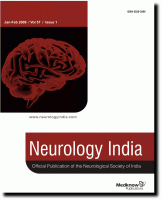 GNE (Glucosamine [UDP-N-acetyl]-2-epimerase/N-acetylmannosamine kinase) myopathy, also known as distal myopathy with rimmed vacuoles (DMRV), hereditary inclusion body myopathy (hIBM), quadriceps-sparing myopathy or Nonaka myopathy, is a clinicopathologically distinct distal myopathy with autosomal-recessive mode of inheritance. Mutations in the GNE gene are known to cause this form of distal myopathy. Over the last 6 years, a total of 54 patients from 48 families were diagnosed to have GNE myopathy based on the clinical and histopathological findings. In this study, the authors have previously reported on 23 cases and from this cohort 12 patients from 11 families underwent genetic testing for GNE mutation. Nine patients (six women and three men) belonging to eight families were confirmed with GNE myopathy by genetic analysis. The mean age of onset was 26.7 ± 5.47 years (20-36 years) and the mean age at clinical examination was 32.3 ± 4.2 years (28-39 years). The mean duration of the illness was 5.7 ± 4.7 years (1-14 years). All had characteristic clinical features of progressive weakness and wasting of the anterior part of leg muscles, adductors and hamstrings with relative sparing of the quadriceps muscles. Biopsy from the tibialis anterior muscles revealed the presence of rimmed vacuoles. Mutation analysis of the GNE gene revealed that c. 2086G > A (p.Val696Met) change was common in this series, with six of the eight families carrying a heterozygous mutation. These results demonstrate the presence of a common mutation in the GNE gene in Southeast Asia.
GNE (Glucosamine [UDP-N-acetyl]-2-epimerase/N-acetylmannosamine kinase) myopathy, also known as distal myopathy with rimmed vacuoles (DMRV), hereditary inclusion body myopathy (hIBM), quadriceps-sparing myopathy or Nonaka myopathy, is a clinicopathologically distinct distal myopathy with autosomal-recessive mode of inheritance. Mutations in the GNE gene are known to cause this form of distal myopathy. Over the last 6 years, a total of 54 patients from 48 families were diagnosed to have GNE myopathy based on the clinical and histopathological findings. In this study, the authors have previously reported on 23 cases and from this cohort 12 patients from 11 families underwent genetic testing for GNE mutation. Nine patients (six women and three men) belonging to eight families were confirmed with GNE myopathy by genetic analysis. The mean age of onset was 26.7 ± 5.47 years (20-36 years) and the mean age at clinical examination was 32.3 ± 4.2 years (28-39 years). The mean duration of the illness was 5.7 ± 4.7 years (1-14 years). All had characteristic clinical features of progressive weakness and wasting of the anterior part of leg muscles, adductors and hamstrings with relative sparing of the quadriceps muscles. Biopsy from the tibialis anterior muscles revealed the presence of rimmed vacuoles. Mutation analysis of the GNE gene revealed that c. 2086G > A (p.Val696Met) change was common in this series, with six of the eight families carrying a heterozygous mutation. These results demonstrate the presence of a common mutation in the GNE gene in Southeast Asia.
> Read full text
